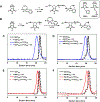Degradable Polyphosphoramidate via Ring-Opening Metathesis Polymerization
- PMID: 35653670
- PMCID: PMC11042488
- DOI: 10.1021/acsmacrolett.0c00401
Degradable Polyphosphoramidate via Ring-Opening Metathesis Polymerization
Abstract
We report the synthesis of a degradable polyphosphoramidate via ring-opening metathesis polymerization (ROMP) with the Grubbs initiator (IMesH2)(C5H5N)2(Cl)2Ru═CHPh. Controlled ROMP of a low ring strain diazaphosphepine-based cyclic olefin was achieved at low temperatures to afford well-defined polymers that readily undergo degradation in acidic conditions via the cleavage of the acid-labile phosphoramidate linkages. The diazaphosphepine monomer was compatible in random and block copolymerizations with phenyl and oligo(ethylene glycol) bearing norbornenes. This approach introduced partial or complete degradability into the polymer backbones. With this chemistry, we accessed amphiphilic poly(diazaphosphepine-norbornene) copolymers that could be used to prepare micellar nanoparticles.
Conflict of interest statement
The authors declare no competing financial interest.
Figures




Similar articles
-
Degradable polymers via olefin metathesis polymerization.Prog Polym Sci. 2021 Sep;120:101427. doi: 10.1016/j.progpolymsci.2021.101427. Epub 2021 Jun 7. Prog Polym Sci. 2021. PMID: 38666185 Free PMC article.
-
Biomass-Derived Degradable Polymers via Alternating Ring-Opening Metathesis Polymerization of Exo-Oxanorbornenes and Cyclic Enol Ethers.ACS Macro Lett. 2023 Dec 19;12(12):1642-1647. doi: 10.1021/acsmacrolett.3c00608. Epub 2023 Nov 20. ACS Macro Lett. 2023. PMID: 37983535
-
A versatile approach for the synthesis of degradable polymers via controlled ring-opening metathesis copolymerization.Nat Chem. 2022 Jan;14(1):53-58. doi: 10.1038/s41557-021-00810-2. Epub 2021 Nov 18. Nat Chem. 2022. PMID: 34795434
-
Grubbs' and Schrock's Catalysts, Ring Opening Metathesis Polymerization and Molecular Brushes-Synthesis, Characterization, Properties and Applications.Polymers (Basel). 2019 Feb 11;11(2):298. doi: 10.3390/polym11020298. Polymers (Basel). 2019. PMID: 30960282 Free PMC article. Review.
-
Tandem Ring-Opening Metathesis - Vinyl Insertion Polymerization: Fundamentals and Application to Functional Polyolefins.Macromol Rapid Commun. 2017 Mar;38(6). doi: 10.1002/marc.201600672. Epub 2017 Feb 7. Macromol Rapid Commun. 2017. PMID: 28169470 Review.
Cited by
-
Regioselective Palladium-Catalyzed Chain-Growth Allylic Amination Polymerization of Vinyl Aziridines.J Am Chem Soc. 2024 Jun 5;146(22):15264-15274. doi: 10.1021/jacs.4c02599. Epub 2024 May 27. J Am Chem Soc. 2024. PMID: 38801413 Free PMC article.
-
Water-soluble polyphosphonate-based bottlebrush copolymers via aqueous ring-opening metathesis polymerization.Chem Sci. 2023 Sep 26;14(40):11273-11282. doi: 10.1039/d3sc02649c. eCollection 2023 Oct 18. Chem Sci. 2023. PMID: 37860667 Free PMC article.
-
Degradable polyolefins prepared by integration of disulfides into metathesis polymerizations with 3,6-dihydro-1,2-dithiine.Chem Sci. 2024 Sep 26;15(41):17084-91. doi: 10.1039/d4sc04468a. Online ahead of print. Chem Sci. 2024. PMID: 39345767 Free PMC article.
-
Degradable polymers via olefin metathesis polymerization.Prog Polym Sci. 2021 Sep;120:101427. doi: 10.1016/j.progpolymsci.2021.101427. Epub 2021 Jun 7. Prog Polym Sci. 2021. PMID: 38666185 Free PMC article.
-
Inflammation-Responsive Micellar Nanoparticles from Degradable Polyphosphoramidates for Targeted Delivery to Myocardial Infarction.J Am Chem Soc. 2023 May 24;145(20):11185-11194. doi: 10.1021/jacs.3c01054. Epub 2023 May 15. J Am Chem Soc. 2023. PMID: 37184379 Free PMC article.
References
-
- Delplace V; Nicolas J Degradable vinyl polymers for biomedical applications. Nat. Chem. 2015, 7, 771–784. - PubMed
-
- Hillmyer MA; Tolman WB Aliphatic Polyester Block Polymers: Renewable, Degradable, and Sustainable. Acc. Chem. Res. 2014, 47, 2390–2396. - PubMed
-
- Semsarilar M; Perrier S ‘Green’ reversible addition-fragmentation chain-transfer (RAFT) polymerization. Nat. Chem. 2010, 2, 811–820. - PubMed
-
- Farah S; Anderson DG; Langer R Physical and mechanical properties of PLA, and their functions in widespread applications - A comprehensive review. Adv. Drug Delivery Rev. 2016, 107, 367–392. - PubMed
Grants and funding
LinkOut - more resources
Full Text Sources

